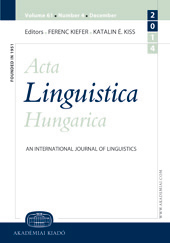Johannes Sylvester’s Grammatical legacy (1539) and its European background
Johannes Sylvester’s Grammatical legacy (1539) and its European background
Author(s): József HegedűsSubject(s): Historical Linguistics, Finno-Ugrian studies, Philology
Published by: Akadémiai Kiadó
Keywords: first linguistic revolution; structure comparison; agglutination; absence of gender; definite article;
Summary/Abstract: In 1539, a peculiar Latin-Hungarian (more precisely: Hungarian-Latin) grammar was published by Johannes Sylvester, dedicating the grammar (probably symbolically) to his son. Unfortunately enough, his grammar got lost in the war-stricken times of the first half of the 16th century. At the end of the 18th century, however, it was found again and then republished. Being lost, the grammar in question could not influence the grammarians of Sylvester’s age.The “discovery” of the mother tongues in Europe, the birth of a new spirituality (Reformation) and the compelling drive to translate the Bible into vernaculars were the unmistakable signs of the first linguistic revolution.The grammar actually is a contrastive analysis of Latin, Greek and a lesser degree German, Hebrew and Hungarian. What is more interesting, its deals with structure and not with single word comparisons. Sylvester was the first in Europe to articulate the basic difference between the chief European languages (Latin, [Ancient] Greek, German and the non-European Hebrew) and Hungarian revealing that Hungarian is of postpositional character; so he was the first in Europe to discover agglutination as the basic feature of Hungarian (though he was not familiar with this term). Among other things, he casually mentions the relationship of Hebrew (the “lingua sancta”) to Hungarian, as was the linguistic trend of his age.
Journal: Acta Linguistica Hungarica (Since 2017 Acta Linguistica Academica)
- Issue Year: 55/2008
- Issue No: 1-2
- Page Range: 41-57
- Page Count: 17
- Language: English

